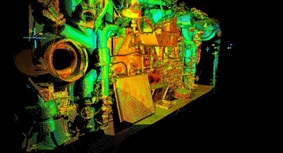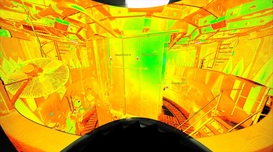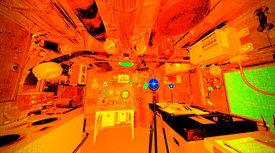Scanning the USS North Carolina (BB-55)
As part of an exploratory cooperative research venture with the Innovation Design lab at East Carolina University, I traveled to Wilmington, North Carolina in May, 2010 to assist with a Terrestrial Laser Scan of several rooms/compartments located within the Battleship USS North Carolina.
A Leica ScanStation 2 and two Leica C10 Laser Scanners, Leica high definition targets and Nodal Ninja (high resolution imagery) were used in the survey.
|
Our work has the potential to benefit the USS North Carolina in a few ways.
-The USS North Carolina is a popular tourist destination drawing hundreds of thousands of visitors a year. Access to areas of the ship for visitors with limited mobility is a problem because of the narrow staircases and hallways. An accurate 3D model of the USS North Carolina, coupled with an immersive visualization chamber (more information here) can solve accessibility problems. An accurate 3D model of the USS North Carolina could extend the battleship's educational reach by providing classrooms all over the world with fly through and interactive displays of the battleship.
- The USS North Carolina is a particularly well preserved relic of World War II, and several movie/documentary companies have used or are planning to use the USS North Carolina in their films. Accurate Terrestrial Laser Scan data and/or models of the USS North Carolina provide unique visualization of the ship's interior. This provides film crews with high-resolution location data, giving them a chance to view the line of sight from multiple perspectives and pre-plan where they will make their shots from before they even step on the set. This increases efficiency and decreases onset mistakes, saving money. The Laser Scanning data can also be modeled to provide accurate animations of the battleship. More information about Laser Scanning in film work can be found here and here.
- The USS North Carolina is now seeking funding for a refurbishment of the ship's hull. A laser scan survey of the ship's hull can provide accurate cost estimates, visualization of the restoration before work begins, and "as built" verification of the restoration, which verifies that the restoration being completed matches the planed restoration. Construction cost estimates and "as built" verification by terrestrial laser scanning are increasingly being used in architecture, engineering and construction (AEC) fields, where significant cost savings have been realized with the use of the technology.
-The USS North Carolina is a popular tourist destination drawing hundreds of thousands of visitors a year. Access to areas of the ship for visitors with limited mobility is a problem because of the narrow staircases and hallways. An accurate 3D model of the USS North Carolina, coupled with an immersive visualization chamber (more information here) can solve accessibility problems. An accurate 3D model of the USS North Carolina could extend the battleship's educational reach by providing classrooms all over the world with fly through and interactive displays of the battleship.
- The USS North Carolina is a particularly well preserved relic of World War II, and several movie/documentary companies have used or are planning to use the USS North Carolina in their films. Accurate Terrestrial Laser Scan data and/or models of the USS North Carolina provide unique visualization of the ship's interior. This provides film crews with high-resolution location data, giving them a chance to view the line of sight from multiple perspectives and pre-plan where they will make their shots from before they even step on the set. This increases efficiency and decreases onset mistakes, saving money. The Laser Scanning data can also be modeled to provide accurate animations of the battleship. More information about Laser Scanning in film work can be found here and here.
- The USS North Carolina is now seeking funding for a refurbishment of the ship's hull. A laser scan survey of the ship's hull can provide accurate cost estimates, visualization of the restoration before work begins, and "as built" verification of the restoration, which verifies that the restoration being completed matches the planed restoration. Construction cost estimates and "as built" verification by terrestrial laser scanning are increasingly being used in architecture, engineering and construction (AEC) fields, where significant cost savings have been realized with the use of the technology.
_This work is based upon work supported by the Office of Engagement,
Innovation and Economic Development at East Carolina University - Thad Wasklewicz, PI



